Abstract
The activities of src tyrosine kinases are greatly influenced by substrate modulators (chaperones). In the presence of bovine serum albumin, the phosphorylation of a random polymer of glutamic acid, alanine, and tyrosine (1:1:1) by src kinases is stimulated 20- to 100-fold, but there is little stimulation with a polymer of glutamic acid and tyrosine (4:1) as substrate. This suggests that serum albumin interacts with the substrates rather than with the enzyme. groEL and several other heat shock proteins also stimulate the phosphorylation of a random polymer of glutamic acid, alanine, and tyrosine (1:1:1). In the absence of substrate modulators, the phosphorylation of calmodulin and of several ras proteins by src kinase is barely detectable. In the presence of polylysine or protamine, marked phosphorylation is observed. Another type of control of src kinase activities appears to be directed toward the enzyme rather than the substrate. Triton X-100 extracts of plasma membranes of bovine brain contain a heat-stable factor that stimulates c-src kinase activity with any of the polymers as substrate. The same extract contains a heat-labile factor that preferentially inhibits c-src kinase activity. The two factors are separated by DEAE-Sephacel and phosphocellulose chromatography. The presence of the activator enhances the potency of the inhibitor.
Full text
PDF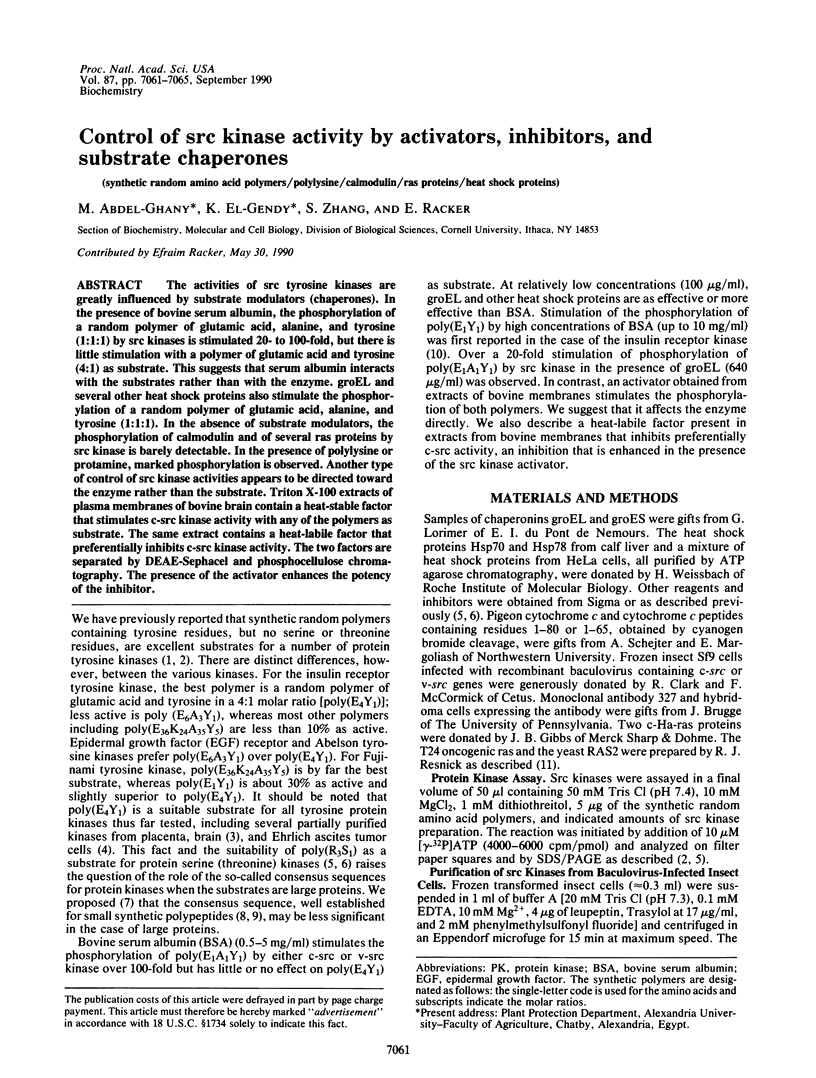
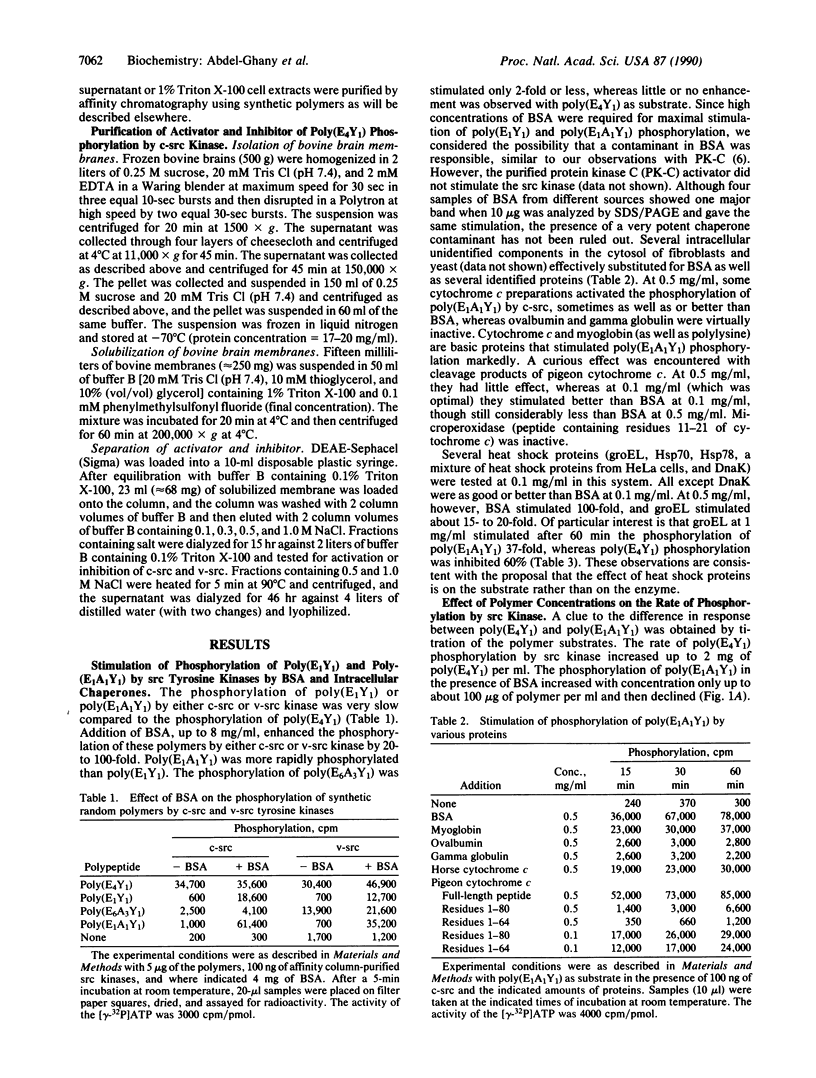
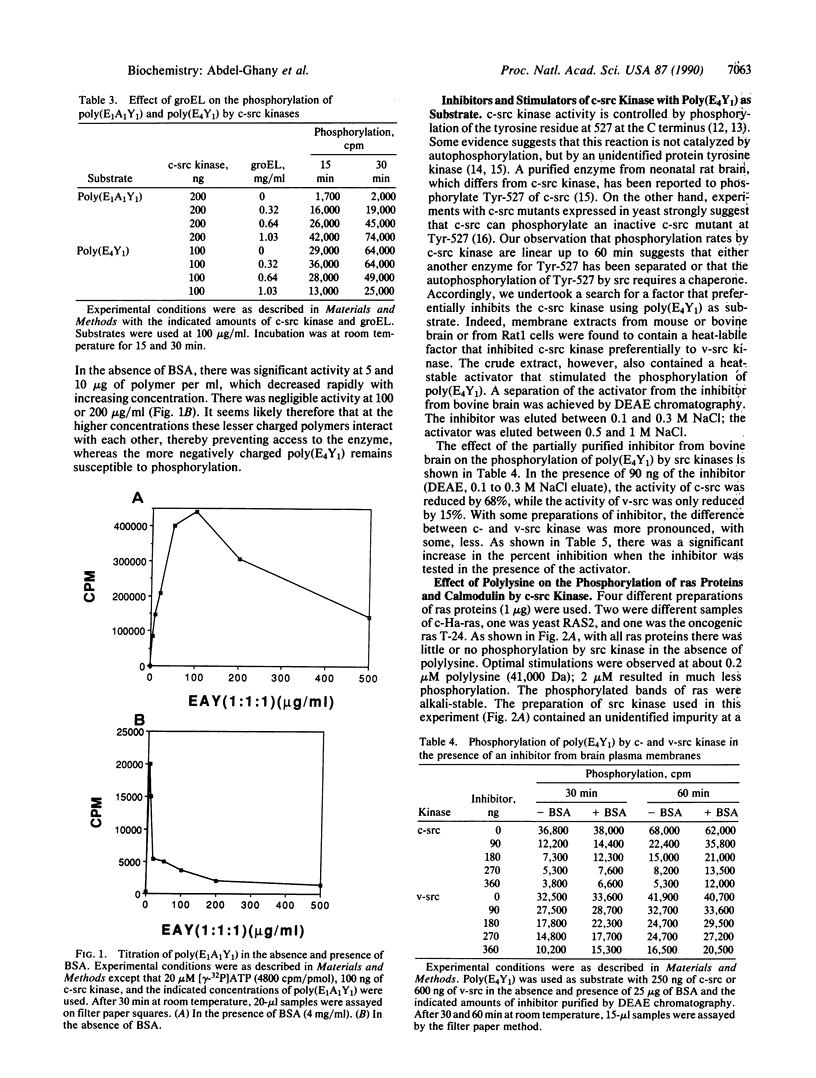
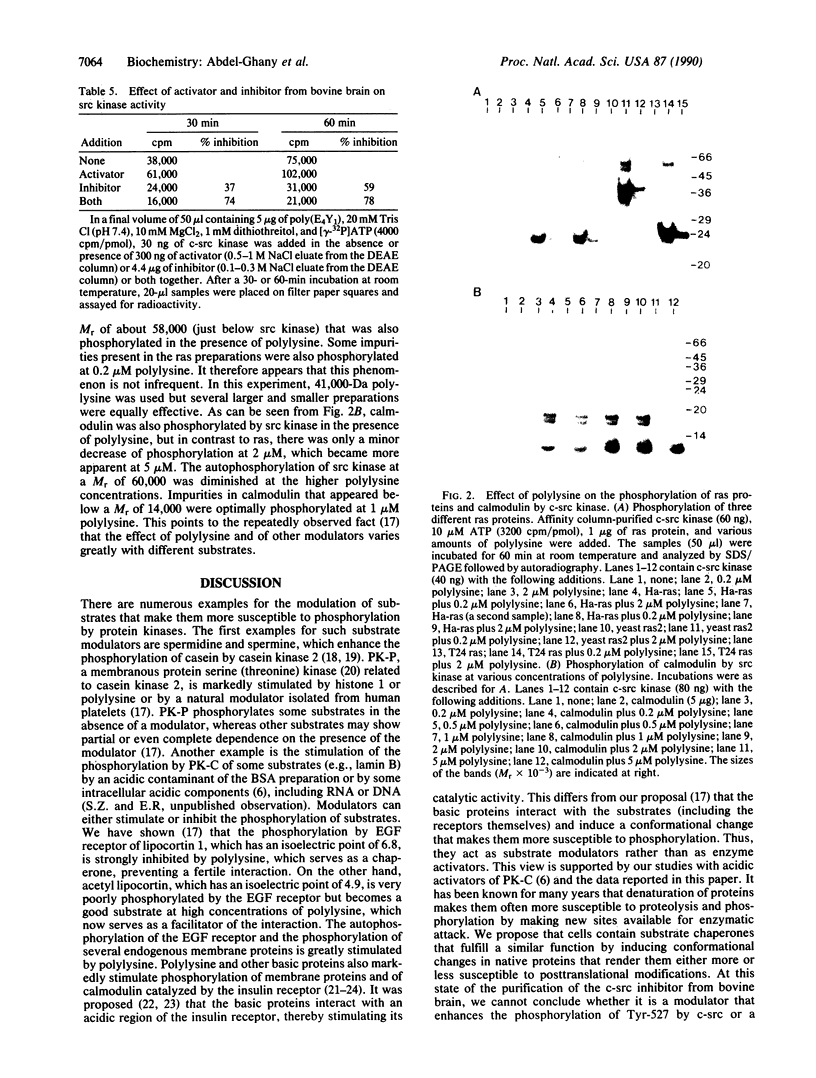
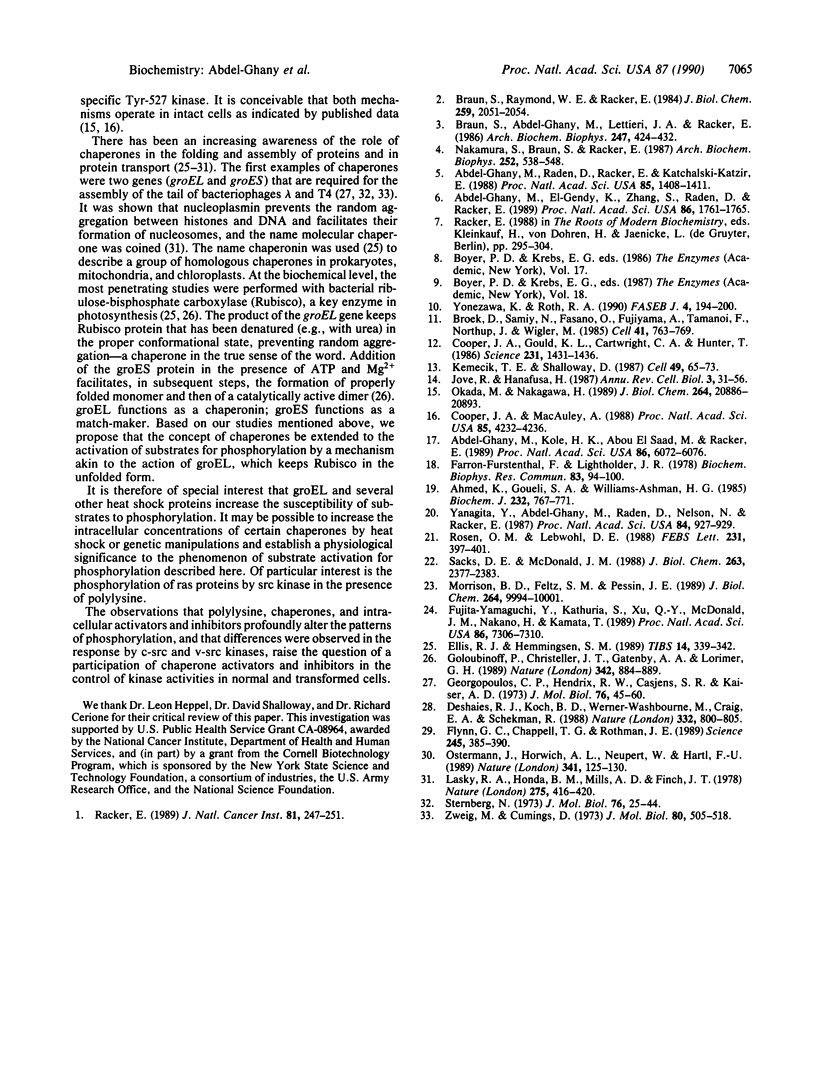
Images in this article
Selected References
These references are in PubMed. This may not be the complete list of references from this article.
- Abdel-Ghany M., Kole H. K., el Saad M. A., Racker E. Stimulation of phosphorylation of lipocortin at threonine residues by epidermal growth factor (EGF) and the EGF receptor: addition of protein kinase P with polylysine inhibits this effect. Proc Natl Acad Sci U S A. 1989 Aug;86(16):6072–6076. doi: 10.1073/pnas.86.16.6072. [DOI] [PMC free article] [PubMed] [Google Scholar]
- Abdel-Ghany M., Raden D., Racker E., Katchalski-Katzir E. Phosphorylation of synthetic random polypeptides by protein kinase P and other protein-serine (threonine) kinases and stimulation or inhibition of kinase activities by microbial toxins. Proc Natl Acad Sci U S A. 1988 Mar;85(5):1408–1411. doi: 10.1073/pnas.85.5.1408. [DOI] [PMC free article] [PubMed] [Google Scholar]
- Abdel-Ghany M., el-Gendy K., Zhang S., Raden D., Racker E. Brain protein kinase C phosphorylating poly(arginine,serine) or lamin B is stimulated by anions and by an activator purified from bovine serum albumin preparations. Proc Natl Acad Sci U S A. 1989 Mar;86(6):1761–1765. doi: 10.1073/pnas.86.6.1761. [DOI] [PMC free article] [PubMed] [Google Scholar]
- Ahmed K., Goueli S. A., Williams-Ashman H. G. Characteristics of polyamine stimulation of cyclic nucleotide-independent protein kinase reactions. Biochem J. 1985 Dec 15;232(3):767–771. doi: 10.1042/bj2320767. [DOI] [PMC free article] [PubMed] [Google Scholar]
- Braun S., Abdel Ghany M., Lettieri J. A., Racker E. Partial purification and characterization of protein tyrosine kinases from normal tissues. Arch Biochem Biophys. 1986 Jun;247(2):424–432. doi: 10.1016/0003-9861(86)90602-8. [DOI] [PubMed] [Google Scholar]
- Braun S., Raymond W. E., Racker E. Synthetic tyrosine polymers as substrates and inhibitors of tyrosine-specific protein kinases. J Biol Chem. 1984 Feb 25;259(4):2051–2054. [PubMed] [Google Scholar]
- Broek D., Samiy N., Fasano O., Fujiyama A., Tamanoi F., Northup J., Wigler M. Differential activation of yeast adenylate cyclase by wild-type and mutant RAS proteins. Cell. 1985 Jul;41(3):763–769. doi: 10.1016/s0092-8674(85)80057-x. [DOI] [PubMed] [Google Scholar]
- Cooper J. A., Gould K. L., Cartwright C. A., Hunter T. Tyr527 is phosphorylated in pp60c-src: implications for regulation. Science. 1986 Mar 21;231(4744):1431–1434. doi: 10.1126/science.2420005. [DOI] [PubMed] [Google Scholar]
- Cooper J. A., MacAuley A. Potential positive and negative autoregulation of p60c-src by intermolecular autophosphorylation. Proc Natl Acad Sci U S A. 1988 Jun;85(12):4232–4236. doi: 10.1073/pnas.85.12.4232. [DOI] [PMC free article] [PubMed] [Google Scholar]
- Deshaies R. J., Koch B. D., Werner-Washburne M., Craig E. A., Schekman R. A subfamily of stress proteins facilitates translocation of secretory and mitochondrial precursor polypeptides. Nature. 1988 Apr 28;332(6167):800–805. doi: 10.1038/332800a0. [DOI] [PubMed] [Google Scholar]
- Ellis R. J., Hemmingsen S. M. Molecular chaperones: proteins essential for the biogenesis of some macromolecular structures. Trends Biochem Sci. 1989 Aug;14(8):339–342. doi: 10.1016/0968-0004(89)90168-0. [DOI] [PubMed] [Google Scholar]
- Farron-Furstenthal F., Lightholder J. R. Effects of polyamines and histones on the phosphorylation of non-histone proteins in isolated rat liver nuclei. Biochem Biophys Res Commun. 1978 Jul 14;83(1):94–100. doi: 10.1016/0006-291x(78)90402-3. [DOI] [PubMed] [Google Scholar]
- Flynn G. C., Chappell T. G., Rothman J. E. Peptide binding and release by proteins implicated as catalysts of protein assembly. Science. 1989 Jul 28;245(4916):385–390. doi: 10.1126/science.2756425. [DOI] [PubMed] [Google Scholar]
- Fujita-Yamaguchi Y., Kathuria S., Xu Q. Y., McDonald J. M., Nakano H., Kamata T. In vitro tyrosine phosphorylation studies on RAS proteins and calmodulin suggest that polylysine-like basic peptides or domains may be involved in interactions between insulin receptor kinase and its substrate. Proc Natl Acad Sci U S A. 1989 Oct;86(19):7306–7310. doi: 10.1073/pnas.86.19.7306. [DOI] [PMC free article] [PubMed] [Google Scholar]
- Georgopoulos C. P., Hendrix R. W., Casjens S. R., Kaiser A. D. Host participation in bacteriophage lambda head assembly. J Mol Biol. 1973 May 5;76(1):45–60. doi: 10.1016/0022-2836(73)90080-6. [DOI] [PubMed] [Google Scholar]
- Goloubinoff P., Christeller J. T., Gatenby A. A., Lorimer G. H. Reconstitution of active dimeric ribulose bisphosphate carboxylase from an unfoleded state depends on two chaperonin proteins and Mg-ATP. Nature. 1989 Dec 21;342(6252):884–889. doi: 10.1038/342884a0. [DOI] [PubMed] [Google Scholar]
- Jove R., Hanafusa H. Cell transformation by the viral src oncogene. Annu Rev Cell Biol. 1987;3:31–56. doi: 10.1146/annurev.cb.03.110187.000335. [DOI] [PubMed] [Google Scholar]
- Kmiecik T. E., Shalloway D. Activation and suppression of pp60c-src transforming ability by mutation of its primary sites of tyrosine phosphorylation. Cell. 1987 Apr 10;49(1):65–73. doi: 10.1016/0092-8674(87)90756-2. [DOI] [PubMed] [Google Scholar]
- Laskey R. A., Honda B. M., Mills A. D., Finch J. T. Nucleosomes are assembled by an acidic protein which binds histones and transfers them to DNA. Nature. 1978 Oct 5;275(5679):416–420. doi: 10.1038/275416a0. [DOI] [PubMed] [Google Scholar]
- Morrison B. D., Feltz S. M., Pessin J. E. Polylysine specifically activates the insulin-dependent insulin receptor protein kinase. J Biol Chem. 1989 Jun 15;264(17):9994–10001. [PubMed] [Google Scholar]
- Nakamura S., Braun S., Racker E. A tyrosine-specific protein kinase from Ehrlich ascites tumor cells. Arch Biochem Biophys. 1987 Feb 1;252(2):538–548. doi: 10.1016/0003-9861(87)90061-0. [DOI] [PubMed] [Google Scholar]
- Okada M., Nakagawa H. A protein tyrosine kinase involved in regulation of pp60c-src function. J Biol Chem. 1989 Dec 15;264(35):20886–20893. [PubMed] [Google Scholar]
- Ostermann J., Horwich A. L., Neupert W., Hartl F. U. Protein folding in mitochondria requires complex formation with hsp60 and ATP hydrolysis. Nature. 1989 Sep 14;341(6238):125–130. doi: 10.1038/341125a0. [DOI] [PubMed] [Google Scholar]
- Racker E. The search for oncogene targets. J Natl Cancer Inst. 1989 Feb 15;81(4):247–251. doi: 10.1093/jnci/81.4.247. [DOI] [PubMed] [Google Scholar]
- Rosen O. M., Lebwohl D. E. Polylysine activates and alters the divalent cation requirements of the insulin receptor protein tyrosine kinase. FEBS Lett. 1988 Apr 25;231(2):397–401. doi: 10.1016/0014-5793(88)80858-5. [DOI] [PubMed] [Google Scholar]
- Sacks D. B., McDonald J. M. Insulin-stimulated phosphorylation of calmodulin by rat liver insulin receptor preparations. J Biol Chem. 1988 Feb 15;263(5):2377–2383. [PubMed] [Google Scholar]
- Sternberg N. Properties of a mutant of Escherichia coli defective in bacteriophage lambda head formation (groE). II. The propagation of phage lambda. J Mol Biol. 1973 May 5;76(1):25–44. doi: 10.1016/0022-2836(73)90079-x. [DOI] [PubMed] [Google Scholar]
- Yanagita Y., Abdel-Ghany M., Raden D., Nelson N., Racker E. Polypeptide-dependent protein kinase from bakers' yeast. Proc Natl Acad Sci U S A. 1987 Feb;84(4):925–929. doi: 10.1073/pnas.84.4.925. [DOI] [PMC free article] [PubMed] [Google Scholar]
- Yonezawa K., Roth R. A. Various proteins modulate the kinase activity of the insulin receptor. FASEB J. 1990 Feb 1;4(2):194–200. doi: 10.1096/fasebj.4.2.2153593. [DOI] [PubMed] [Google Scholar]
- Zweig M., Cummings D. J. Cleavage of head and tail proteins during bacteriophage T5 assembly: selective host involvement in the cleavage of a tail protein. J Mol Biol. 1973 Nov 5;80(3):505–518. doi: 10.1016/0022-2836(73)90418-x. [DOI] [PubMed] [Google Scholar]




